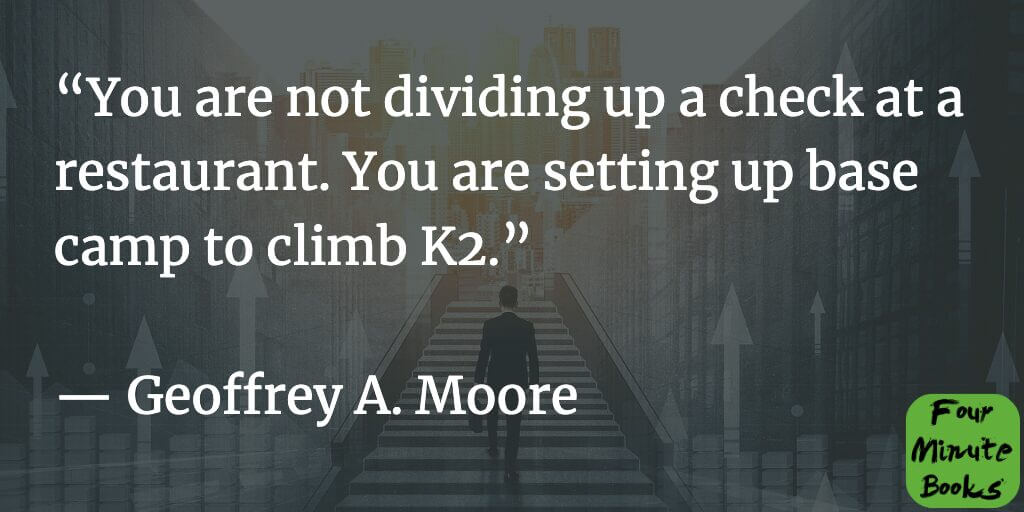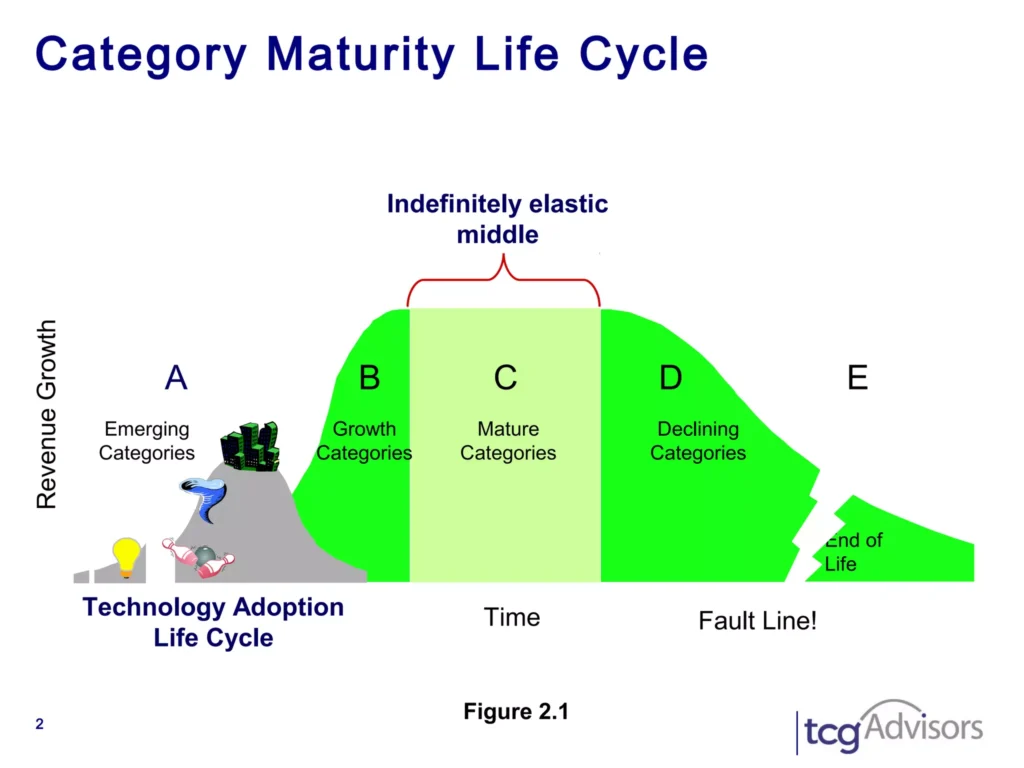1-Sentence-Summary: Escape Velocity offers a hierarchy of five powers that determine any business’s ability to achieve large-scale, long-term success, including its chosen industry, position with competitors and customers, product portfolio, and inner efficiency, making useful suggestions on optimizing these factors in order to stay relevant for decades to come.
Read in: 4 minutes
Favorite quote from the author:

Everybody in the world of business, especially in big tech, knows the name Geoffrey Moore. The reason is a book called Crossing the Chasm.
Published in 1991, Moore’s seminal work describes how new technologies can go from appealing only to early adopters to reaching the mass market. It’s a playbook used to this day: Facebook first rolled out only to US college campuses, and TikTok started as Musical.ly focused on helping teenagers make cool lip-sync videos, for example.
If you ask me, however, Moore’s most popular work is far from his greatest. That title should go to Escape Velocity: Free Your Company’s Future from the Pull of the Past. Years ago, Medium CEO Tony Stubblebine pointed me to a talk Moore gave about this book, which he published 20 years after Crossing the Chasm, and it changed how I think about business forever.
Whether you wish to start a business, already have, or work at a big corporation whose collective decisions you don’t always understand, this book will give you a holistic framework from which you can analyze any business and figure out how it might succeed.
Here are 3 lessons from Escape Velocity:
- A hierarchy of 5 powers determines how long any business will survive.
- Without category power, all the others don’t matter.
- Your offer power is determined by your ability to differentiate, neutralize, and optimize.
Let’s learn what it takes for a company to continuously reinvent itself!
Lesson 1: Your company’s longevity is determined by a hierarchy of 5 powers.
Many a company that was once the world’s #1 in their industry no longer exists. Motorola. Silicon Graphics. Polaroid. Others are shells of their former selves. Nokia, Kodak, At&T, anyone? Why? Because they consumed their power instead of maintaining it.
Power is different from performance, which is the thing corporate culture tends to focus on, Moore explains. Annual reports, quarterly figures, and sales targets dominate the conversation, but they miss the point: What’s your unique contribution to the world, what industry are you in, and where do those two leave you with customers and competitors?
Even if it’s not initially compensated, in the long run, any business must replenish its power. There are 5 ways to do so, and they form a hierarchy in order of importance:
- Category Power: Are you in organically growing industries or shrinking ones?
- Company Power: Who’s the team to beat in your industry?
- Market Power: Are you chasing the right customer segments? And are you winning them?
- Offer Power: Is your flagship offering something customers can’t get anywhere else? Or are you playing catch-up?
- Execution Power: How efficient are you at driving change in all of the above?
If you look at your business through these 5 lenses, you’ll start focusing on the right long-term activities instead of just your next buck. You’ll know exactly which levers to pull for what reason. Let’s look at 2 of them in more detail.
Lesson 2: Category Power is the most important determinator of whether your business will grow or shrink.
In 2010, the world-famous magazine Newsweek was sold for a single dollar. Meanwhile, 3Par, “a not particularly distinguished storage company,” sold for $2.3 billion. Why? Category power. Computer storage was hot, print media was not.
“Category power is the number-one predictor of future economic performance.” It’s determined by a simple question: Is your industry growing or not? “If you’re in a category that’s growing 100%, even if you’re kind of a doofus, you’re probably going to do pretty well this year,” Moore says. Meanwhile, you can fight tooth and nail in a stagnant industry and only eke out a 1% gain.

To understand your category power, consider the 5 stages most industries go through:
- Emerging Category: Your industry is new and shiny, but will it ever succeed?
- Growing Category: The mainstream is confirmed to be coming — and fast!
- Mature Category: The industry is now stable, predictable, and slowly grows in cycles.
- Declining Category: Though slowly, the inevitable decline has begun.
- End of Life Category: Still selling faxes? Okay, you’ve overstayed your welcome. Get out now!
More than anything else, ensure you’re in the right category for what you’re trying to do. It’s your single-best source of power.
Lesson 3: Offer Power is how you neutralize, improve upon, and differentiate yourself from the competition.
In 2011, with the iPhone still new-ish and the iPad just out, Apple was the poster child of power. Today, many people claim the company has lost its magic touch. Enter the Apple Vision Pro, their first augmented/virtual reality headset. Where other products are made of plastic, use controllers, and cost around $300, Apple’s is made of metal and glass, works only with your hands, and costs $3,500. Is it perfect? No, but folks are going nuts over it, and that is the point: getting into people’s heads.
While differentiation is the crucial factor, there are 3 activities that determine your offer power overall:
- Differentiation is how you stand out from everyone else by using your core strengths.
- Neutralization is about delivering the minimum standard all customers expect. Don’t become “the same as X, but worse.”
- Optimization means learning from your failures, redirecting otherwise wasted resources, and innovating in productivity so you have the time and money to work on differentiation.
Domino’s, for example, at one point made terrible pizza that arrived late. They improved the recipe and promised to deliver within 30 minutes. Once they did those two things consistently, the competition was neutralized, and the brand became unstoppable.
Differentiation is hard and requires delivering a 10x improvement, but it often pays dividends for decades to come. “Skype created a 10X reduction in consumer long-distance telephony costs by offering it for free,” Moore says. “Wikipedia created a 10X improvement in the accessibility and currency of an encyclopedia.”
You might not be Apple, but if you play your cards right, your company, too, can develop tremendous offer power. Use the frameworks from this book to run your business, and maybe it’ll become one of the few we’ll still talk about in the 22nd century and beyond.
Escape Velocity Review
Geoffrey Moore’s Escape Velocity lays out the cleanest, most practical business analysis framework I’ve ever come across. Whether you’re a big tech CEO or solo creative, I’m sure you will learn something valuable from this book. Oh, and you can even apply the hierarchy of powers to your own life and career, and that comes with plenty of interesting lessons too. A phenomenal book all around!
Who would I recommend our Escape Velocity summary to?
The 21-year-old business student who feels her management classes aren’t teaching her anything, the 45-year-old senior corporate executive who wants to make a real dent in the business strategy, and anyone who wants to launch their own product.